|
|
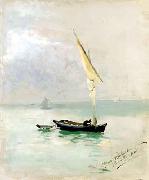 |
Anna Bilinska-Bohdanowicz
|
|
(1857-1893) was a Polish painter, known for her portraits. She was born as Anna Biliska, a daughter of Polish doctor in Ukraine, where she spent her childhood. She lived with her father in Russia, before studying music and art in Warsaw.
She went later to study at the Academie Julian in Paris. She lived in France until 1892, when she married a medical doctor named Bohdanowicz and she took his name (Anna Bilieska-Bohdanowicz).
They returned to Warsaw after their marriage, where she died a year later of heart attack.
Her paintings are known from the reproductions of her portraits of women and often reproduced view of the Unter den Linden in Berlin from 1890.
|
|
|
|
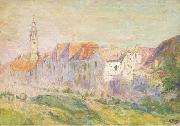 |
Anna Boch
|
|
(10 February 1848 - 25 February 1936) was a Belgian painter, born in Saint-Vaast, Hainaut. Anna Boch died in Ixelles in 1936 and is interred there in the Ixelles Cemetery, Brussels, Belgium.
Boch participated in the Neo-Impressionist movement. Her early works used a Pointillist technique, but she is best known for her Impressionist style which she adopted for most of her career. A pupil of Isidore Verheyden, she was influenced by Theo van Rysselberghe whom she met in the Groupe des XX.
|
|
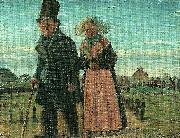 |
anna brondum
|
|
Omkring 1900 drog en rad av kvinnliga konstnärer från Norden mot Frankrike, Italien, Tyskland och andra länder i Europa. Hanna Pauli, Sigrid Hjerten och Anna Bröndum är i dag kända, men den vårgårdafödda Hilda Heyman hörde också till dessa målande kvinnor. Hon är inte så känd men väl erkänd i konstnärliga kretsar och representerad på många konstmuseer. |
|
 |
Anne Baptiste Nivelon
|
|
Portrait de Louis de France, dauphin (1729 - 1765) represente tenant des plans militaires |
|
|
|
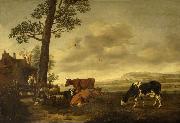 |
Anthonie van Borssom
|
|
(January 2, 1631, Amsterdam - march 19, 1677, Amsterdam), was a Dutch Golden Age landscape painter.
According to the RKD he was an Italianate landscape painter who copied works of popular landscape painters of his day in Amsterdam such as Jacob van Ruisdael, Paulus Potter, Aelbert Cuyp (church interieurs), Nicolaes Berchem, Philips Koninck, Jan Wijnants, Aert van der Neer (moonlit landscapes), and Cornelis Vroom. He lived and worked in Amsterdam but made a trip in 1650-1655 along the Rhine and spent time in Kleve.He was buried in the Westerkerk. |
|
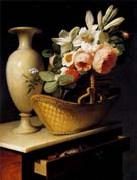 |
Antoine Berjon
|
|
French Romantic Painter, 1754-1843,French painter, teacher and designer. According to his uncorroborated 19th-century biographer J. Gaubin, he was intended for holy orders and began studying flower painting as a novice (Rev. Lyon., i, 1856). Certainly he studied drawing under the sculptor Antoine-Michel Perrache (1726-79) and worked for Lyon's silk industry as a textile designer, visiting Paris annually, ostensibly to keep abreast of the latest fashions. He first exhibited at the Paris Salon of 1791 and settled in Paris in about 1794, probably as a consequence of the catastrophic siege and destruction of Lyon by revolutionary forces the previous year. Initially he eked out a precarious living decorating snuff-boxes and painting miniatures, supported by friends such as Marceline Desbordes-Valmore, the poetess, and the miniature painter Jean-Baptiste Augustin, to whom Berjon dedicated The Gift (1797; Lyon, Mus. B.-A.). He contributed to seven Paris Salons between 1796 and 1819 and again in 1842, and he had built up a considerable reputation for his work by the early 19th century. |
|
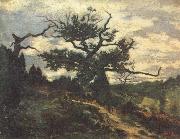 |
Antoine louis barye
|
|
French Romantic Sculptor and Painter, ca.1795-1875, He was a French sculptor most famous for his work as an animalier. Born in Paris, Barye began his career as a goldsmith, like many sculptors of the Romantic Period. After studying under sculptor Francois-Joseph Bosio and painter Baron Antoine-Jean Gros he was in 1818 admitted to the Ecole des Beaux Arts. But it was not until 1823, while working for Fauconnier, the goldsmith, that he discovered his true predilection from watching the wild beasts in the Jardin des Plantes, making vigorous studies of them in pencil drawings comparable to those of Delacroix, then modelling them in sculpture on a large or small scale. In 1831 he exhibited his "Tiger devouring a Crocodile", and in 1832 had mastered a style of his own in the "Lion and Snake." Thenceforward Barye, though engaged in a perpetual struggle with want, exhibited year after year these studies of animals--admirable groups which reveal him as inspired by a spirit of true romance and a feeling for the beauty of the antique, as in "Theseus and the Minotaur" (1847), "Lapitha and Centaur" (1848), |
|
 |
Antoni Boys
|
|
Antoni Boys
artist in 14th century to 15th century |
|
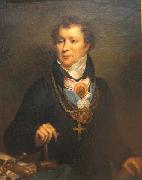 |
Antoni Brodowski
|
|
(26 December 1784 - 31 March 1832) was a Polish Neo-classicist painter and pedagogue. Brodowski was born in Warsaw but moved to Paris to study under Jean Augustin and Jacques-Louis David, later Brodowski's idol. He also became a pupil of Anne-Louis Girodet and Francois Gerard. His compositions are very large-scale with many figures, and often based on themes from Antiquity. Brodowski is also well-known for his decorative paintings within palaces and theatres in Warsaw.
|
|
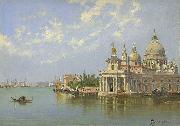 |
Antonietta Brandeis
|
|
(1849, Miskowitz (Czech: Myslkovice) - 1920), was an Austrian painter.[1][2]
Select Museum Collections: Museum Revoltella, Trieste
|
|
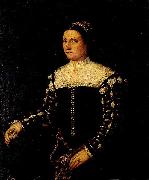 |
Antonio Badile
|
|
Antonio Badile (c. 1518 - 1560) was an Italian painter from Verona. He trained with his uncle Francesco Badile. Along with Giovanni Francesco Caroto, Antonio is known as one of the mentors of Paolo Veronese and Giovanni Battista Zelotti; as well as his father-in-law. Badile is described as continuing the "retardataire" tradition of Giovanni Francesco Caroto well past the 1540s. His masterpiece is the altarpiece for San Nazaro of a Madonna and Saints (1540); another notable work is his Resurrection of Lazarus for the chapel of Santa Croce in the church of San Bernardino. Other works are found in towns of the Veneto. |
|
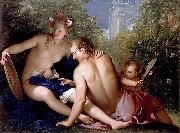 |
Antonio Bellucci
|
|
Antonio Bellucci (1654-1726) was an Italian painter of the Rococo period, who was best known for his work in England, Germany, and Austria. He was one of the many Venetian-trained artists of his time, including Ricci, Tiepolo, Amigoni, and others, who sought commissions north of Italy, providing patrons with the then-popular Italianate grand-manner frescoes for private palaces.
|
|
|
|
|
|
|
|
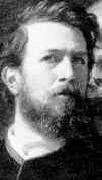 |
Arnold Bocklin
|
|
Swiss
1827-1901
Arnold Bocklin Locations
Arnold Bocklin was born on Oct. 16, 1827, in Basel. He attended the Dusseldorf Academy (1845-1847). At this time he painted scenes of the Swiss Alps, using light effects and dramatic views subjectively to project emotional moods into the landscape. In 1848 this romantic introspection gave way to plein air (open-air) objectivity after he was influenced by Camille Corot, Eugene Delacroix, and the painters of the Barbizon school while on a trip to Paris. But after the February and June revolutions Bocklin returned to Basel with a lasting hatred and disgust for contemporary France, and he resumed painting gloomy mountain scenes.
In 1850 Bocklin found his mecca in Rome, and immediately his paintings were flooded by the warm Italian sunlight. He populated the lush southern vegetation, the bright light of the Roman Campagna, and the ancient ruins with lonely shepherds, cavorting nymphs, and lusty centaurs. These mythological figures rather than the landscapes became Bocklins primary concern, and he used such themes as Pan Pursuing Syrinx (1857) to express the polarities of life: warm sunshine contrasts with cool, moist shade, and the brightness of womans spirituality contrasts with mans dark sensuality.
When Bocklin returned to Basel with his Italian wife, he completed the painting which brought him fame when the king of Bavaria purchased it in 1858: Pan among the Reeds, a depiction of the Greek phallic god with whom the artist identified. He taught at the Academy of Art in Weimar from 1860 to 1862, when he returned to Rome. Called to Basel in 1866, he painted the frescoes and modeled the grotesque masks for the facade of the Basel Museum.
Bocklin resided in Florence from 1874 until 1885, and this was his most active period. He continued to explore the male-female antithesis and painted religious scenes, allegories of Natures powers, and moody studies of mans fate. He ceased working with oils and began experimenting with tempera and other media to obtain a pictorial surface free of brushstrokes.
Bocklin spent the next 7 years mostly in Switzerland, with occasional trips to Italy; he devoted much of his energy to designing an airplane. Following a stroke in 1892, he returned to Italy, bought a villa in Fiesole, and died there on Jan. 16, 1901. Many of his late works depict nightmares of war, plague, and death. |
|
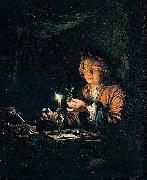 |
Arnold Boonen
|
|
Arnold van Boonen was a Dutch eminent portrait painter, was born at Dordrecht, in the Dutch Republic in 1669. He was first a scholar of Arnold Verbius, and was later instructed by Godefried Schalken. He painted genre pictures in the style of the latter, representing subjects by candlelight, but met with such encouragement in portrait painting that he devoted himself almost wholly to that branch of art. His style was well adapted to succeed in it. An excellent oolourist, a faithful designer of his model, and highly skilled, he was soon distinguished as one of the ablest artists of his day. He painted a great number of portraits of the most distinguished people of his time, among whom were Peter the Great, the Elector of Mentz, the Landgrave of Hesse-Darmstadt, the Prince and Princess of Orange, the great Duke of Marlborough, and several others. He painted some large pictures for the halls of the different companies at Amsterdam and Dordrecht. He died in 1729.
The Dresden Gallery has seven works by him, and the 'Woman Singing' in the Lille Gallery is also attributed to him. His son, Kasper van Boonen, also painted portraits, but in no way proved himself equal to his father.
|
|
|
|
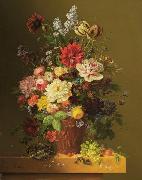 |
Arnoldus Bloemers
|
|
born at Amsterdam in 1792, painted flowers, fruit, and animals. He was instructed by Antonie Piera, but principally imitated Van Huijsum. He died at the Hague in 1844. The Rotterdam Gallery has a flower-piece by him.
|
|
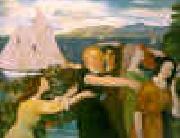 |
Arthur Bowen Davies
|
|
1862-1928
Arthur Bowen Davies Gallery
Arthur Bowen Davies (September 26, 1863 ?C October 24, 1928) was an avant-garde American artist.
He was born in Utica, New York and studied at the Chicago Academy of Design from 1879 to 1882. He briefly attended the Art Institute of Chicago and then moved to New York City where he studied at the Art Students League.
Davies was a principal organizer of the 1913 Armory Show and was a member of The Eight, a group of painters including five associated with the Ashcan school: William Glackens (1870-1938), Robert Henri (1865-1929), George Luks (1867-1933), Everett Shinn (1876-1953) and John French Sloan (1871-1951), along with Arthur B. Davies (1862-1928), Ernest Lawson (1873-1939) and Maurice Prendergast (1859-1924). Davies is best known for his ethereal figure paintings. He worked as a billboard painter, engineering draftsman, and magazine illustrator. |
|
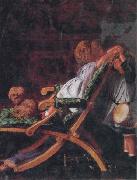 |
Arthur Boyd Houghton
|
|
English Painter and Illustrator , 1836-1875
His work was varied and was revered during the mid-19th century. He traveled to America and Russia, creating illustrations for The Graphic and for numerous books, including The Arabian Nights and Don Quixote. His work was strongly influenced by the Pre-Raphaelite Brotherhood. Paul Hogath wrote a biography, published in 1981 by Gordon Fraser Work by this artist is held within various public collections incluiding Tate Britain in London, as well as a number of private collections around the world. Houghton is best known for etchings but also produced a number of oil paintings, many of his wife and children. He also wrote a little poetry which was published in his lifetime. |
|
 |
AST, Balthasar van der
|
|
Dutch Baroque Era Painter, ca.1593-1656
1657). Dutch painter. He was the brother-in-law of Ambrosius Bosschaert (i), whose household he entered in 1609, after the death of his father. He remained as Bosschaert's pupil, until he was 21. In 1615 van der Ast moved with the Bosschaert family to Bergen-op-Zoom. However, a year later the Bosschaerts were living in Utrecht, but van der Ast is not recorded there until 1619, when he was entered as a master in the Guild of St Luke. He remained in Utrecht until 1632, then lived in Delft, where he enrolled in the painters' guild on 22 June 1632. On 26 February 1633 he married Margrieta Jans van Bueren in Delft, where he spent the rest of his career; the marriage produced two children. |
|
|
|
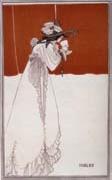 |
Aubrey Beardsley
|
|
English Art Nouveau/Golden Age Illustrator, 1872-1898
English draughtsman and writer. He was brought up in Brighton, in genteel poverty, by his mother. She gave her children an intensive education in music and books, and by the time he was sent to boarding-school at the age of seven Beardsley was exceptionally literate and something of a musical prodigy. He was also already infected with the tuberculosis that eventually killed him. There is evidence that his talent for drawing was highly developed by the age of ten, and he was subsequently encouraged by his housemaster at Brighton Grammar School, Arthur William King. Beardsley left school at the end of 1888, and in January 1889 became a clerk at the Guardian Life and Fire Insurance Company in the City of London. Attacks of haemorrhaging of the lungs forced him to abandon his job at the end of 1889. On the strength of a short story sold to Tit Bits he tried to pursue a literary career, but when his health improved in the spring of 1890, he returned both to his job and to drawing. Final affirmation of the direction of his art came in July 1891, when he showed his work to Edward Burne-Jones, who told Beardsley: 'I seldom or never advise anyone to take up art as a profession, but in your case I can do nothing else. |
|
|
|
|
|
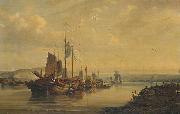 |
Auguste Borget
|
|
Auguste Borget (1808-1877) was a French artist who is best known for his drawings and prints of exotic places, in particular China. He was born in 1808 in Issoudun, Indre. At age 21, he went to Paris where he became a close friend of Honore de Balzac. Borget periodically exhibited at the Paris Salon from 1836 to 1859. Beginning in 1836, he traveled through North and South America before stopping briefly in Honolulu in May, 1838, on board the ship "Psyche", on a world tour. He went to Canton in September 1838 and stayed in the region for 10 months. While in Canton, he met the English artist George Chinnery, and they went on sketching trips together.
In July 1839 he visited Manila, Singapore and Calcutta. In 1840 he traveled widely in India, returning to Paris in the summer of that year. Borgetes sketches and watercolors from China were the basis for his most famous publication "Sketches of China and the Chinese", published in 1842. His book "La Chine ouverte" was illustrated with fine woodcut engravings. A major Salon of his original works, including watercolors and boldly executed oil paintings was held in Paris in 1843. Borget died in 1877. |
|
|
|
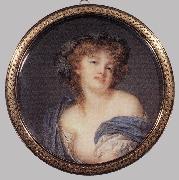 |
AUGUSTIN, Jacques-Jean-Baptiste
|
|
French miniaturist (b. 1759, Saint-Di? d. 1832, Paris)
1832). French painter. After receiving instruction in art from Jean Girardet (1709-78) and Jean-Baptiste-Charles Claudot (1733-1805), he went to Paris in 1781, where he won recognition as a miniature painter. The miniatures he painted in the 1790s, for example his portrait of Mme Vanh?e, n?e Dewinck (1792; Paris, Louvre), are among his most animated works; often portraying figures in a landscape setting, they develop the exuberant style of Niclas Lafrensen and Peter Adolf Hall. He also admired the work of Jean-Baptiste Greuze, whose Bacchante (Waddesdon Manor, Bucks, NT) in his own collection he copied in miniature (London, Wallace) and in enamel (Paris, Louvre). |
|
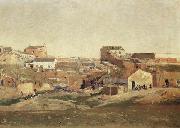 |
Aureliano De Beruete Y Moret
|
|
Spanish , Madrid, 1845 - Madrid, 1912
Spanish writer, painter and collector. After pursuing a political career and taking a doctorate in civil and canon law, he dedicated himself to writing on art and produced important studies on Diego Velezquez (1898), Joaqu'n Sorolla y Bastida (1901) and other artists. He travelled extensively and enthusiastically in Europe (France, Belgium, Switzerland, the Netherlands, Italy, Germany, England and elsewhere), studying especially the different national schools of painting. On his travels he also painted landscapes. After working for some time as a copyist in the Museo del Prado, Beruete decided in 1873 to concentrate his efforts on painting and on learning to perfect his craft. He enrolled at the Escuela Superior de Bellas Artes de S Fernando in Madrid and also studied at the studio of Carlos de Haes. Beruete was among the founders of the Instituci'n Libre de Enseeanza, and with its members, and with Carlos de Haes, he made several study trips abroad. In Paris he came to know the painting of the Barbizon school, and in Belgium he assimilated the teaching of the generation of landscape artists who had adopted a form of Realism. |
|
|
|
|
|
 |
Ayne Bru
|
|
Ayne (Aine) Bru (probably a Catalanization of Hans Bren) was a 16th century Renaissance painter of German origin who worked in Catalonia. He may have proceeded from Lummen, in the Duchy of Brabant. He is sometimes also called Lucius de Brun. His surname may also suggest provenance from the town of Brenn.
In 1502, he was hired to paint the main altar (retablo) in the church of the monastery of Sant Cugat del Valles, for which he was paid a staggering wage between 1504 and 1507.
On the central panel, Bru depicted the martyrdom of Saint Cucuphas (in Catalan, Sant Cugat) with enormous realism. The executioner cuts the saint's throat while Cucuphas remains tied to a tree trunk. Nearby, there appear another knife (in a basket) and a dog sleeping peacefully. This work is now at the National Art Museum of Catalonia (Museu Nacional d'Art de Catalunya).
The dog from Bru's painting of Cucuphas' martyrdom was later borrowed by Salvador Dale for a painting called "Dale Contemplating Nude" or "Dale Dale Dale".
The vast countryside that serves as a background anachronistically includes the actual monastery of Sant Cugat. Another panel, depicting Saint George (sometimes identified as Saint Candidus or simply as "Warrior Saint"), was attached to this one. It has been rejoined and is visible at the National Art Museum of Catalonia.
Marcel Durliat believes that though the expressionism in this painting is evidence of a Germanic artistic tradition, Bru's Quattrocento depiction of the standing figures in contemporary dress, as well as other details, indicate that the painter may have lived or studied in Northern Italy before moving to Barcelona. |
|
|
|
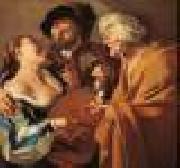 |
BABUREN, Dirck van
|
|
Dutch Baroque Era Painter, 1595-1624
1624). Dutch painter. His father, Jasper van Baburen (d ?1599), had been in the service of Geertruijd van Bronckhorst van Battenburg, Baroness (vrijvrouw) of Vianen, Viscountess (burggravin) of Utrecht, and thus Dirck must have received a better than average education, a fact at least partially confirmed by the innovative and often literary nature of his subject-matter. In 1611 he is recorded as a pupil of the portrait and history painter Paulus Moreelse in Utrecht. It is likely that this was the last year of his apprenticeship. Van Baburen probably left for Italy shortly after 1611, for a document rediscovered in the late 1980s records a signed and dated altarpiece of the Martyrdom of St Sebastian (1615; untraced), executed for a church in Parma. His most important pictures made in Italy were painted in collaboration with David de Haen (d 1622) for the Piet? Chapel of S Pietro in Montorio, Rome, which was decorated between 1615 and 1620. Van Baburen's paintings for the chapel were mentioned by Giulio Mancini in his manuscript notes, Considerazioni sulla pittura (c. 1619-20); there Mancini claims the artist was 22 or 23 years old when he carried out the commission. One of his best-known works, the Entombment (formerly dated 1617), is still in situ on the altar of the chapel. This much-copied composition reveals van Baburen's close study of Caravaggio's famous Entombment (Rome, Pin. Vaticana). In 1619 and the spring of 1620 van Baburen and de Haen were recorded as living in the same house in the Roman parish of S Andrea delle Fratte. Caravaggio's close follower and presumed student, Bartolomeo Manfredi, was living in the same parish in 1619. Van Baburen must have known the works of Manfredi. |
|
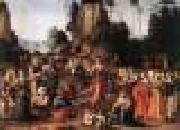 |
BACCHIACCA
|
|
Italian Painter, 1494-1557
Francesco Bacchiacca (1494 - 1557) was a Italian painter of the Renaissance whose work is characteristic of the Florentine Mannerist style.
Bacchiacca was born in Borgo San Lorenzo, near Florence. He was also known as Bachiacca or Bacchiacca, Francesco d'Ubertino Verdi or Francesco Ubertini. He initially was a craftsman in an atelier of possibly Pietro Perugino. In 1523, he participated with Franciabigio and Jacopo Pontormo in the decoration of the camera of Giovanni Benintendi. He mainly worked in small cabinet pieces, or designs for tapestries. Sogliani's Deposition, a theme commonly addressed by many Florentine artists, is addressed in a cartoonish form. |
|
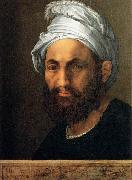 |
Baccio Bandinelli
|
|
(17 October 1493 - shortly before 7 February 1560), was a Renaissance Italian sculptor, draughtsman and painter.
Bandinelli was the son of a prominent Florentine goldsmith, and first apprenticed in his shop. As a boy, he was apprenticed under Giovanni Francesco Rustici, a sculptor friend of Leonardo da Vinci. Among his earliest works was a Saint Jerome in wax, made for Giuliano de' Medici, identified as Bandinelli's by John Pope-Hennessy
Giorgio Vasari, a former pupil in Bandinelli's workshop, claimed Bandinelli was driven by jealousy of Benvenuto Cellini and Michelangelo; and recounts that:
|
|
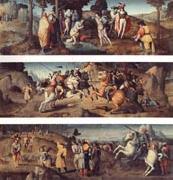 |
Bachiacca
|
|
Italian painter, Florentine school (b. 1494, Firenze, d. 1557, Firenze). |
|
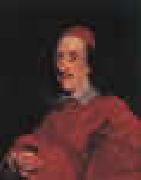 |
Baciccio
|
|
Italian Baroque Era Painter, 1639-1709
Baciccia
Giovanni Battista Gaulli |
|
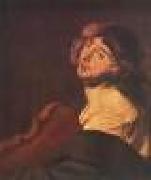 |
BACKER, Jacob Adriaensz.
|
|
Dutch Baroque Era Painter, 1608-1651
Backer was born in Harlingen, but his family moved soon (in 1611) to Amsterdam. Between 1627 and 1633 he and Govert Flinck were pupils of Lambert Jacobsz in Leeuwarden. In 1633 he returned to Amsterdam, where he remained until his death.
His extreme quickness in painting portraits has been particularly noticed, and it is said by his Amsterdam colleague Joachim von Sandrart that he completely finished, in one day, the half length portrait of a lady in full dress, even so early, that she was able to return the same day to Haarlem. Besides being an important portrait painter - some 70 portraits can be attributed to him with certainty, among them the 1642 Company of Cornelis de Graeff voor de Nieuwe Doelen in Amsterdam, on the same wall as Rembrandt's Night Watch - Backer was an excellent painter of religious and mythological paintings. He was especially interested in pastoral subjects, themes from contemporary history, like the huge Crowning of Mirtillo from 1641 in the Brukenthal collection in Sibiu (250 x 250 cm.). In fact, Backer was a leading artist in Amsterdam until his premature death in 1651. |
|
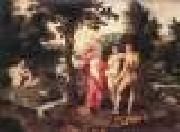 |
BACKER, Jacob de
|
|
Flemish painter (b. 1555/60, Antwerpen, d. 1585/90, Antwerpen)
Flemish painter and draughtsman. According to van Mander, as a young boy de Backer was abandoned by his father, also a painter, who had to flee Antwerp because of an impending court trial. Jacob then worked for several years in the studio of Antonio van Palermo (1503/13-before 1589) and later entered the workshop of Hendrick van Steenwijck. Van Mander further claimed that the strenuous labour that van Palermo had imposed on the young man had so wrecked his health that he died at the age of 30, in the arms of his former master's daughter. This, van Mander added, happened a long time ago, thus implying that de Backer died before van Steenwijck left Antwerp in 1586. This is confirmed by other evidence, including the age of van Palermo's daughter Lucretia, who was baptized in Antwerp on 25 July 1561. She lived until 1626 and at the time of her death still possessed six paintings by de Backer. |
|
 |
BACKHUYSEN, Ludolf
|
|
Dutch Baroque Era Painter, ca.1631-1708
Ludolf Backhuysen (or Bakhuizen) (Dec 28, 1630 - Nov 17, 1708) was a Dutch painter, born in Emden, Hanover.
Bakhuysen started his career as a bookkeeper. He had a very nice handwriting and loved arithmetic. Working for a wealthy merchant at Amsterdam, he discovered so strong a genius for painting that he relinquished the business and devoted himself to art. He studied first under Allart van Everdingen and then under Hendrik Dubbels, two eminent masters of the time, and soon became celebrated for his sea-pieces.
He was an ardent student of nature, and frequently exposed himself on the sea in an open boat in order to study the effects of storms. His compositions, which are numerous, are nearly all variations of one subject, the sea, and in a style peculiarly his own, marked by intense realism or faithful imitation of nature. In his later years Backhuysen employed his skills in etching and calligraphy.
During his life Backhuysen was visited by Cosimo III de' Medici and Peter the Great. In 1699 he opened a gallery on the topfloor of the famous Amsterdam townhall. After a visit to England he died in Amsterdam on November 17, 1708. |
|
|
|
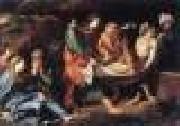 |
BADALOCCHIO, Sisto
|
|
Italian Baroque Era Painter, 1585-ca.1619
Italian painter and etcher. His formation as an artist took place within the Carracci circle. According to Malvasia, he may have attended the Carracci Academy in Bologna, before returning to Parma in 1600 as the pupil of Agostino Carracci when the latter entered the service of Ranuccio I Farnese, 4th Duke of Parma. After Agostino's death in 1602, Badalocchio and his fellow pupil Giovanni Lanfranco were sent by the Duke to Rome in order to complete their training in the studio of Annibale Carracci, who was then working in the Palazzo Farnese. Badalocchio remained with Annibale until the latter's death in 1609. He participated in most of the projects that occupied the studio assistants during those years, such as the frescoes on the walls of the Galleria in the Palazzo Farnese and those previously in the Herrera Chapel in S Maria di Monserrato, Rome (now detached and divided between Madrid, Prado, and Barcelona, Mus. A. Catalunya), although his precise share in them is still debated. His first signed works are etchings, one (1606) after the antique sculpture of the Laokoon (Rome, Vatican, Mus. Pio-Clementino) and 23 (1607, part of a series of 54 executed in collaboration with Lanfranco) after Raphael's frescoes in the Vatican Logge; they reveal the romanizing character of his training. Yet his independent paintings of this early period reveal the influence of Lanfranco, which was to last throughout his career; the lively play of light and shade suggests his allegiance to Emilian art.
|
|
|
|
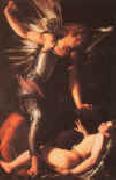 |
Baglione
|
|
1573-1644
Italian painter, draughtsman and writer. He executed canvases and frescoes of religious and mythological subjects, and portraits. He was given important commissions by popes and aristocrats and sold his works to patrons in Italy and abroad. Bagliones arguably greater fame as a writer derives from Le nove chiese di Roma (1639) and especially from his Vite de pittori, scultori, architetti (1642), containing biographies of more than 200 artists who worked in Rome between 1572 and 1642.
|
|
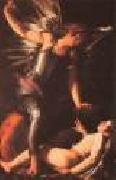 |
BAGLIONE, Giovanni
|
|
Italian Baroque Era Painter, active 1573-1644
A pupil of Francesco Morelli, he worked mainly in Rome, initially with a late-Mannerist style. He was also nicknamed Il Sordo del Barozzo. He published two books, The nine churches of Rome (1639) and The Lives of Painters, Sculptors, Architects and Engravers (active from 1572-1642)(1642). The last title is still seen as an important historical source for painters living in Rome during the life of Baglione.
Among those he chronicled, and for whom he was notorious in his animosity was Caravaggio, whose style had influenced him much. The latter was forced to leave the city after Baglione's accusations of sodomy. Baglione's Sacred love versus profane love, a response to Caravaggio's Love Victorious, shows an angel (Sacred Love) interrupting a 'meeting' between Cupid (Profane Love) and the Devil (portrayed with the face of Caravaggio).
He was employed in many considerable works in Rome during the pontificates of Clement VIII and Paul V. His main works are frescoes which can be seen in the Santa Maria Maggiore in Rome, in the Cappella Borghese. For the church of Santa Maria dell'Orto he painted in the chapel of Our Lady with the Zuccheri scenes from the life of the Blessed Virgin. Among other works which he executed for this church is a painting of Saint Sebastian. An excellent example of Baglione's work is The Last Supper at San Nicola in Carcere. From his brush also there is a Saint Stephen in the Cathedral at Perugia, and in that of Loreto a Saint Catherine. Pope Paul V knighted Baglione a Knight of the Order of Christ for his painting of Saint Peter Raising Tabitha from the Dead (1607) in St. Peter's Basilica. He also painted a St. Stephen for the cathedral of Perugia, and a St. Catharine for the cathedral of Loreto. The Giustizia hall at the Rocca dei Rossi was completely frescoed by Baglione. He died at Rome. |
|
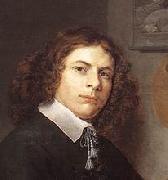 |
BAILLY, David
|
|
Dutch Baroque Era Painter, 1584-1657
Dutch painter and draughtsman. The son of a Flemish immigrant who was a calligrapher and fencing-master, Bailly was apprenticed to a local surgeon-painter and then to Cornelius van der Voort (1576-1624), a portrait painter in Amsterdam. In the winter of 1608 he started out as a journeyman, spending a year in Hamburg and then travelling through several German cities to Venice and Rome. On the return voyage he visited several courts in Germany, working for local princes, including the Duke of Brunswick-Wolfenb?ttel. While no works survive from the immediate period following his return to the Netherlands in 1613, descriptions in old sale catalogues suggest that he may have produced history paintings in the manner of his contemporaries Pieter Lastman and the Pynas brothers. |
|
|

